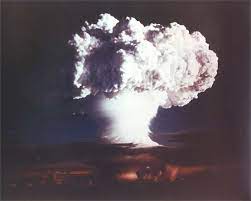January 7, 1953, stands as a pivotal moment in the history of nuclear weapons development, marking the successful testing of the first thermonuclear or hydrogen bomb by the United States. This momentous event, codenamed "Operation Ivy Mike," represented a quantum leap in the destructive power of nuclear weapons and had far-reaching implications for global geopolitics and the Cold War arms race. The hydrogen bomb, often referred to as the H-bomb, was a new class of nuclear weapon that far surpassed the capabilities of the atomic bomb. While the atomic bomb relied on nuclear fission, the hydrogen bomb utilized nuclear fusion, a process that powers the sun. The fusion reaction in an H-bomb is initiated by the intense heat and pressure generated by a conventional atomic bomb, creating a devastatingly powerful explosion. Operation Ivy Mike took place on the remote Pacific atoll of Eniwetok in the Marshall Islands. The test was part of the United States' efforts to advance its nuclear weapons capabilities and maintain a strategic edge in the escalating Cold War with the Soviet Union. The H-bomb represented a qualitative shift in destructive potential, with the ability to yield explosions thousands of times more powerful than the atomic bombs dropped on Hiroshima and Nagasaki in 1945. The device detonated on January 7, 1953, had a yield estimated at 10.4 megatons, making it the most powerful explosive device ever created up to that point. The mushroom cloud that billowed into the sky marked the dawn of a new era in nuclear weaponry. The successful testing of the H-bomb signaled to the world that a terrifying threshold had been crossed, raising concerns about the unprecedented scale of destruction that could be unleashed in a global conflict. The geopolitical ramifications of the hydrogen bomb were profound, intensifying the arms race between the United States and the Soviet Union. The Soviet Union conducted its first successful test of an H-bomb in 1955, escalating the nuclear competition between the two superpowers. The development and possession of hydrogen bombs became a symbol of military prowess and a deterrent against potential adversaries. The proliferation of thermonuclear weapons also heightened fears of nuclear annihilation and sparked a global movement advocating for nuclear disarmament. The devastating power of the H-bomb underscored the urgent need for international agreements to prevent the uncontrolled spread of nuclear weapons. This eventually led to the creation of the Treaty on the Non-Proliferation of Nuclear Weapons (NPT) in 1968, a landmark international treaty aimed at preventing the spread of nuclear weapons and promoting peaceful uses of nuclear energy. January 7, 1953, marked a technological and geopolitical turning point that shaped the trajectory of the Cold War and the global security landscape. The successful testing of the hydrogen bomb not only elevated the destructive potential of nuclear weapons but also fueled an arms race that defined the power dynamics between the world's major nations for decades to come. The legacy of the H-bomb test serves as a stark reminder of the enduring challenges posed by the existence and proliferation of nuclear weapons in the modern world.
7 January 1953 H-Bomb
